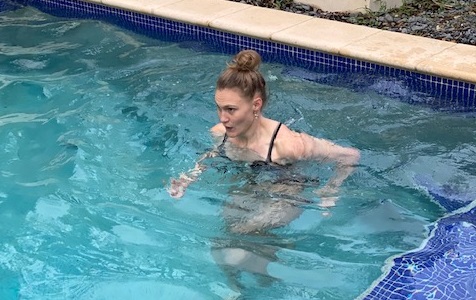Water running with Caitlin
As the weather warms up, many of us are looking for cooler exercise options. Water running is a great choice as it can be scaled up and down for fitness and experience level. With the added summer benefit of being in the water.
There are a few different ways you can engage in water running – each with varying technique, intensity and muscles used. Since water provides resistance to movement, all forms of water running will load the hip flexors more than normal walking and running. So this is worth keeping in mind if you have injuries or known strength issues in this area.
Shallow water running
The buoyancy of water means that running in the pool is a great low impact way to introduce the body to running. Running along the bottom of the pool means you can start to learn the mechanics of running without the same impact. Most public pools have either a shallow end or even a couple of shallow lanes that mean you can run along. Gently contacting the bottom of the pool while keeping your upper body out of the water. I would recommend this for people who are more hesitant in the water or are looking for a way to increase their tolerance to impact in preparation for return to running (eg following a stress fracture or pregnancy). Whilst you can scale the intensity of this up and down, generally this kind of water running won’t elevate your heart rate as much. So its a better choice for people with a lower level of cardiovascular fitness.
Deep water running
The other alternative is to run in the deeper water. Staying afloat will usually require a higher intensity and therefore result in a higher heart rate. This makes it a good option for people wanting to cross-train to maintain fitness during an injury. Given that these forms are higher intensity in nature, they are better suited to interval efforts. For example: 30 seconds work, 30 seconds rest x 20. Rather than a steady state effort for 20 minutes. There are two different technical approaches to deep water running outlined below. Both can be done with or without a floatation belt. Not using the belt is a way to increase the intensity/difficulty, as you have to generate all the energy to stay afloat.
“Run”
Trying to mimic as close as possible to usual running technique. Getting knees up, toes up and cycling through along with arm swing. This form of water running in particular will load the hip flexors heavily so might need to be paired with hip flexor muscle releases
Arm focused run
Thinking of the leg action more as a freestyle kick/flutter (whilst still staying upright in a run position). Focusing more on a strong and fast arm drive. This comparatively is less load on the hip flexors, but more load on the abs and shoulder muscles.
If you’re looking for different forms of exercise to incorporate into your routine, have a chat with your physio about whether water running could be suitable for you. You can book with us online here.








Leave a Reply
Want to join the discussion?Feel free to contribute!